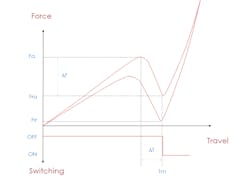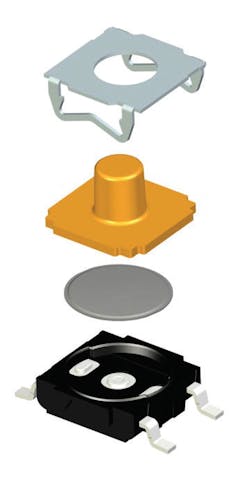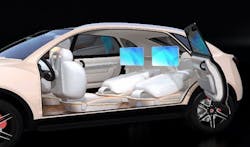Emerging Automotive Switch Applications
What you’ll learn:
- With the evolution of autonomous technology, the modern vehicle cabin features customized electromechanical switches that maximize functionality and optimize comfort, safety, infotainment, and more.
- Among the trends derived from AI is an increase in miniature detect/snap switches in seats.
- Utilizing a switch manufacturer for designs beyond the switch itself helps realize greater flexibility in design.
The development of artificial intelligence (AI) for autonomous vehicles (AVs) is changing the rider experience. Fully autonomous vehicles will lead to a complete overhaul of the vehicle cockpit. In fact, we’ve already seen major changes in cockpits that feature semi-autonomous capability.
Functionality and comfort are primary factors driving the transformation of the automotive interior. Considering the increasing number of functions in these vehicles, designers and engineers must devote time to optimize the user interfaces between the driver and their new environment.
As the gateway to a user interface, a switch solution must have a desirable appearance, haptic feel, and sound. The look, feel, and method for interface interaction is one way vehicle manufacturers separate themselves from competing automakers. To achieve that goal, switch manufactures work closely with automotive makers to optimize aesthetics, ergonomics, and performance.
Haptics
Haptics are directly linked to the switch’s mechanical features (Fig. 1). It’s a combination of:
- Actuation force (Fa)
- Actuation return force (Fra)
- Tactile effect (Fa-Fra = ΔF) often voiced in % (ΔF/Fa = Δ%)
- Mechanical travel (Tm)
- Return force (Frr)
Switch manufacturers can adapt or change the components and parameters to create a unique haptic experience that defines an OEM product. From short-travel products with a strong click and loud noise, to a long-travel product with silent actuation, customization is the hallmark of today’s vehicles (Fig. 2).
Automotive OEMs are focusing more on sound responses and consider the acoustic response as part of their branding. The audible response depends greatly on the switch design, and vehicle manufacturers need to have the same sound response for all units, regardless of the switch configuration. The actuation sound, typically categorized as inaudible, soft, low, “metallic,” or loud, can be controlled by the internal design, the mechanical properties, and the materials used.
To provide solutions that deliver repeatable audible responses, switch manufacturers have established platforms that allow designs to carry over to different applications. They offer high reliability and consistent haptics from an automotive-driven series, while also drastically reducing development cost and time.
OEMs are approaching electromechanical component manufacturers for more than just the switch. By utilizing a switch manufacturer for designs beyond the switch itself, increased flexibility in design can be realized. Switch dimensions are becoming more critical, making it imperative to work closely with customers to discern all details.
Today, it’s less about the switch being mounted to a printed circuit board or adding wire leads or a connector to the switch, and more about defining the functionalities that need to be added or design challenges that must be solved. Because switch manufacturers now deal with the entire module, they’re spending more time with customers to determine how the module is being impacted in the application to assess potential challenges that weren’t previously considered.
Emerging Application Examples
Security and Safety
The automotive market is experiencing a major technological renaissance. The introduction of AI and driverless vehicles will change the way drivers and passengers interact in the vehicle. Driverless cars will lead a complete overhaul of the vehicle cockpit. In fact, we’ve already seen major changes in cockpits that feature semi-autonomous capability. Functionality and comfort are primary factors driving the transformation of the automotive interior.
Amongst other elements within the cockpit, seats are becoming more than just the place you sit to drive—or not drive. The quest for lightweight solutions in automotive interiors is affecting seats, but not to the detriment of the functions added to it:
- Position and lumbar controls: Traditional seat user settings and seat motor management including seat adjustment/movement, memory, lumbar control, heating, ventilation, and massage.
- Comfort detection: Ability to detect seat element position.
Two major trends derived from AI are an increase for miniature detect/snap switches in the seats. Previously, in an application that relied on the availability of miniature tactile technology, the same application can now be better served by smaller, more flexible detect switch designs.
In neighborhood electric vehicles (NEVs), the structure has changed to a full flat floor (Fig. 3). It allows for a rearrangement of the interior, with configurations like business class seats for passengers. In these configurations, the systems need to know whether the seat is in its upright position or in relax or cargo mode to activate/deactivate security and safety systems like airbags.
The second trend is being spurred on by semi-autonomous driving. When in pilot mode, the seat will move to a working/relaxing position and return to a standard position when the manual mode is activated back. Here again, the systems need to know the configuration to trigger security and safety systems.
Gaming
Infotainment systems will reign supreme in autonomous vehicles. And more specifically, gaming. Major vehicle manufacturers are already working on incorporating gaming capabilities directly into the functionality of vehicle.
One example of this trend is using the gear shifter paddles and steering wheel as gaming controls when the vehicle is in park. Detection switches are required to confirm the vehicle is in park and gaming functionality can be employed. Multiuse detect switches also are required in the shifting paddles, as dual functionality is implemented to shift gears in real-life and virtually.
The appeal of employing detect switches as opposed to alternative switch technologies like pushbuttons and snap-acting and slide switches is that they’re smaller and more flexible by design. The flexibility of detect switches is paramount to meeting the many requirements of automotive applications. One such example is the angles with which a switch is capable of operating and subsequently detecting. Because many customized detect switches involve custom tooled contacts, these devices can be tailored to meet any number of vehicle detect requirements.
In addition to miniaturization and versatility, detect switches also offer higher reliability. In fact, detect switches have been implanted into the high-actuation consumer market, including traditional gaming devices. Gaming devices employ such switches to detect the presence of the game card.
Many vehicles utilize rotary switches to navigate through infotainment selections. Operated by rotating the switch dial, multi-use rotary switches are able to stop in different positions to control different circuits with a single switch. Rotary switches also can be designed to have many contacts happening at once on a single switch position.
Rotary switches have a rotating spindle that can be customized to deliver precise tactile and audible feedback while rotating. Depending on the number of rotors, the switch may have dozens of different positions and each one can be attached to a particular circuit.
Joysticks
Multifunction control will be a way of the future. Expect more adaptive joysticks to be integrated into vehicles to offer more sophisticated vehicle control (Fig. 4). Today’s vehicles already offer a combo automatic/manual gear shift with the slide of the joystick control.
Gaming functionality can be added to multifunction grips that combine bidirectional snap-acting switch models with a single switch function in both directions or a double function in both directions. These rugged grips, already available on off-road type vehicles, provide superior tactile feedback and positive snap-point action.
Joystick controls require an electromechanical device with an extremely reliable and repeatable switch mechanism. It’s critical for the switch’s operating position to be consistent over time. Switch manufacturers are achieving this goal with calibrated snap-acting switches to ensure accuracy and reliability.
The design of a snap-acting switch inherently features a precise actuator position for the entirety of the devices’ operating life, a characteristic not necessarily true of other mechanisms. This ensures a redundant and consistent engagement of a joystick or navigational control mechanism, providing smooth and accurate control for the operator, regardless of the speed of actuation.
In addition, snap-acting switches, such as C&K’s TFS Series, help improve reliability. Snap-acting switches feature a robust design and high-life expectancy that’s required for off-highway applications. They can be rated up to IP67 with an operating life of up to 300,000 cycles.
With variations from surface-mount and through-hole, to snap-in and snap-acting, lever actuation and over-travel detect switches are being customized to meet any criteria, making them suitable for automotive joysticks.
Conclusion
Automotive interface designs aim to simplify and enhance the user experience. Electromechanical switches are integral to defining the touch, feel, and sound of interface actuation. With the evolution of autonomous technology, the modern vehicle cabin features customized electromechanical switches that maximize functionality and optimize comfort, safety, infotainment, and more.
Customized for specific vehicles and manufacturers, advanced switching for these emerging in-cabin applications is often accomplished through sophisticated switch configurations. Autonomous vehicles will offer more bells and whistles than ever before, and electromechanical switches must enable multifunctionality to simplify design and integration while improving the user experience.
About the Author
Jerome Smolinski
Market Industry Manager - Automotive, C&K Switches
Jerome Smolinski is currently Automotive segment leader for C&K. Graduating from ESTA (Belfort-France) and with a micromechanics background, he’s been in the connector and switches industry for over 25 years. He joined C&K in 2002, managing different product lines and other responsibilities before moving last year to market management, focusing his C&K expertise on automotive and the automotive interior in particular.




